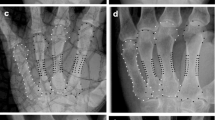Abstract
In order to determine the accuracy of reports of demineralization based on observations of routine radiographs of the peripheral skeleton, paris of radiographs with known difference in bone mineral density (BMD) were shown to a panel of medically qualified observers. No significant difference in the rate of correct identification of osteopenia of metaphyseal and diaphyseal bone was observed. Experienced observers were more accurate than their juniors. The probability of correct identification was greater than 0.5 at all levels of BMD difference, and in general increased with increasing BMD differences, reaching a probability of 0.6 at a BMD difference of 30%. The probability increased considerably when the essesment relied on the majority vote of three or more observers. It is concluded that it is inadvisable for a single observer to judge BMD when studying routine X-ray studies of the peripheral skeleton.
Similar content being viewed by others
References
Andresen J, Nielsen HE (1986) Assessment of bone mineral content and bone mass by non-invasive radiologie methods. Acta Radiol [Diagn] (Stockh) 27:609
Ardran GM (1951) Bone destruction not demonstrable by radiography. Br J Radiol 24:107
Barnett E, Nordin BEC (1960) The radiological diagnosis of osteoporosis: A new approach. Clin Radiol 11:166
Bloom PA (1980) A comparative estimation of combined cortical thickness of various bone sites. Skeletal Radiol 5:167
Cockshott WP, Park WM (1983) Observer variation in skeletal radiology. Skeletal Radiol 10:86
Fusi DG (1953) Saggio sperimentale sulle prime manifestazioni radiologiche di osteoporosi. Radiol Clin 22: 123
Geusens P, Dequeker J, Verstraeten A, Nijs J (1986) Age-, sex-, and menopause-related changes of vertebral and peripheral bone: Population study using dual and single photon absorptiometry and radiogrammatry. J Nucl Med 27:1540
Johnston CC, Epstein S (1981) Clinical, biochemical, radiographic, epidemiologic, and economic features of osteoporosis. Orthop Clin North Am 12:559
Krokowski E (1966) Möglichkeiten zur Bestimmung des Skelett-Calciumgehaltes in der Klinik. Dtsch Med Wochenschr 91:60
Lachman E (1955) Osteoporosis: The potentialities and limitations of its roentgenologic diagnosis. AJR 74:712
Naucler LOW, Nilsson BE, Westlin NE (1974) An apparatus for gamma absorptiometry of bone — Technical data. Orpuscula Medico-Technica Lundensia 12
Reifenstein EC (1957) Definitions, terminology and classification of metabolic bone disorders. Clin Orthop 9:30
Wahner HW, Dunn WL, Riggs BL (1984) Assessment of bone mineral. Part 1. J Nucl Med 25:1134
Wahner HW, Dunn WL, Riggs BL (1984) Assessment of bone mineral. Part 2. J Nucl Med 25:1241
Author information
Authors and Affiliations
Rights and permissions
About this article
Cite this article
Finsen, V., Anda, S. Accuracy of visually estimated bone mineratization in routine radiographs of the lower extremity. Skeletal Radiol 17, 270–275 (1988). https://doi.org/10.1007/BF00401810
Issue Date:
DOI: https://doi.org/10.1007/BF00401810




